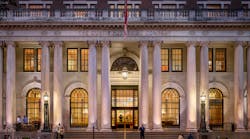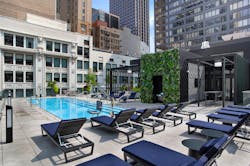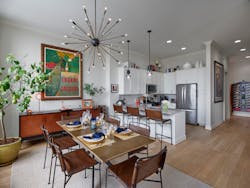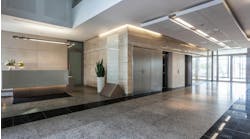Converting underutilized offices is one opportunity to address the short supply of multifamily housing. Especially in urban cores, there are numerous buildings that aren’t attracting corporate tenants but could be repositioned as apartments.
Here are three reasons these properties are ready for a new life as someone’s home, plus a look at two projects in Chicago and Philadelphia.
1. Good Bones
There are already established methods for converting warehouses, hotels and schools into apartments, so transitioning an office is not new engineering territory. Look for a building with a shallow floorplate because the exterior walls are a premium for light penetration, ventilation and life safety codes.
“The best distance is 60 to 80 feet, though modern buildings with light wells can work too. Pay attention to the column grid and if it will fall between dividing walls rather than inside units,” noted Michael Brookshier, VP of Development for Keystone.
Older buildings typically possess historic charm with unique architecture details and a compelling story. For example, The Curtis in Philadelphia features a rare Tiffany glass mural. Even the tall ceiling heights common in prewar construction are ideal for apartments.
2. Location
Buildings that are part of amenitized neighborhoods are attractive reuse candidates because they’re already connected to municipal and social infrastructure.
“We’re in a world where work from home is here to stay to a certain degree. Cities have historically been centers of business, yet many now have an office surplus. We can make our urban centers vibrant by adding multifamily so people can live, work and play within a small radius,” stressed Cindy Delein, principal with Stantec.
“Adaptive reuse is an essential part of redeveloping our downtowns,” Brian O'Donnell, Stantec vice president, added. “But not every empty office needs to be fully converted into residential—mixed use also has economic viability. Some combinations are residential with office, hotel or even office and retail.”
3. Sustainability
Much of a building’s embodied carbon is present in its structural steel and concrete. Yet these components are saved with adaptive reuse. Envelope improvements, such as new windows and insulation, and efficient mechanicals also contribute to a better carbon footprint.
“There are even operational gains with power consumption, as an office has huge electrical loads compared to condos running household appliances and computers,” Brookshier noted.
Due Diligence
Not every vacant office is a good fit for apartment conversion. Code complications, historic preservation requirements, energy regulations or a total gut might skew the financial picture.
“Prepare for larger contingences,” Delein advises. “Especially in older facilities, gotchas could be remediating hazardous materials, changing vertical circulation to satisfy code and updating accessibility.”
“Always have more than one reason for preserving the building,” stressed Rick Whitney, VP of FitzGerald. “There is a perception that adaptive reuse is cheaper than new construction, but that’s not always the case. Plus almost every project runs into difficult zoning or code issues. Be prepared to meet with the building department early to identify and resolve challenges from the beginning.”
Millennium on LaSalle (Chicago)
“The Millennium on LaSalle matches a lifestyle and generational shift where walkability, not car ownership, is the priority. The idea is that people want to live close to their jobs and use public transport,” explained Rick Whitney, VP of FitzGerald. “Features like courts for bocce ball and basketball, a dog spa and run, poolside lounge, rooftop deck and bike storage also help tenants focus on health and wellness.”
Lyndon at The Curtis (Philadelphia)
From a landmark publishing company to a bustling combination of residential and biotech workspace, The Curtis Building is an adaptive reuse all-star. The conversion revives the 1910 headquarters with an emphasis on life sciences office space and labs. Four floors are dedicated to luxury apartments.
“We wanted to leverage what is a fantastic office experience and provide that same feeling to tenants,” explained Michael Brookshier, VP of Development for Keystone. “There are 86 residences, including on the upper stories with arched windows. The property has unbeatable views of Independence Hall and Washington Square Park. Amenities include separate elevators, yoga and spin studio, billiards parlor, library, private movie theatre and private dining room.”




